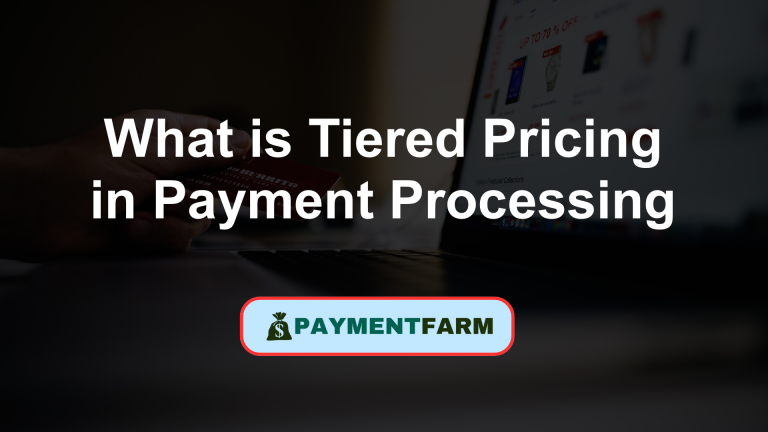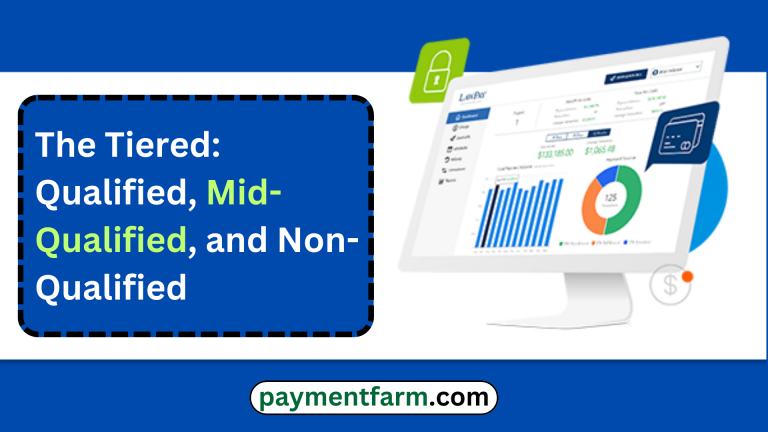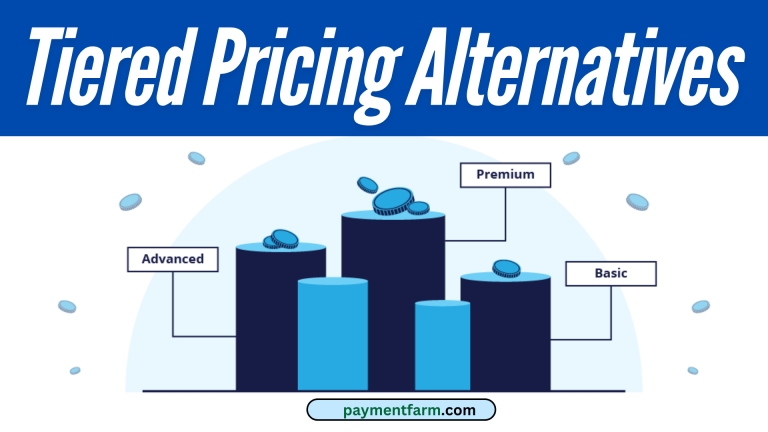As has been stated above, tiered pricing is the payment model most processors use to calculate how much merchants should pay for each credit card transaction they accept. They then categorize the transactions into different levels according to how they are processed. Payment service providers then determine the price levels for each of these. Instead of a flat rate, the fees depend on the tier a transaction falls under, which usually depends on the credit card type and how the payment was made. Let’s take a look.

What Is Tiered Pricing in Credit Card Processing?
- Qualified: This is the most basic tier. Qualified transactions are the simplest type of credit card processing. Low-cost transactions made with standard credit cards fall under this category. Merchants benefit from lower prices in credit card processing fees.
- Mid-qualified: The fees for mid-qualified transactions are more than those in the qualified tier. Processing transactions in the next tier is a little more complicated as they involve payments made online, over the phone, and with rewards cards.
- Non-qualified: It covers the most complicated transactions and therefore is the costliest. These are generally high-risk transactions, including corporate card payments or bypassing some security standards. Although these tiers vary in their fees, they are the same in their key components. The first key component is the transaction fee, which is the base cost merchants must pay for each credit card transaction. Another component is the interchange fee, set by card issuers. Lastly, the fees also include a processor markup, which the payment processor sets.
How Tiered Pricing Compares with Others
Another payment processing pricing structure is known as tiered pricing. Some other popular merchant account pricing models include flat-rate and interchange-plus pricing.
Flat-rate pricing
In flat-rate pricing, the merchant pays a set price for all credit card processing fees. The fee is not subject to changes according to the card or transaction type. This pricing scheme provides ease and predictability for business owners. It can be more costly, however, for companies processing large volumes of transactions.
Interchange-plus pricing
The interchange-plus pricing model obligates merchants to pay an interchange fee set by the credit card networks and a fixed fee set by payment processors. This pricing model is more transparent because merchants will know how much they’re paying their credit card processor and how much goes to the card network.
Tiered pricing
Merchants often prefer tiered merchant account pricing as the model is simple. They can choose a payment processor that offers pricing options that best match the transaction types they handle. Payment processors estimate all the costs of processing credit cards and bundle all the fees into tiers. However, this also leads to the biggest disadvantage of the tiered pricing model lack of transparency. Merchants are usually unaware of how payment processors have categorized transactions, why certain fees apply, and why others do not. Another key advantage of the tiered pricing structure is that it enables companies to keep credit card processing costs low, as they can select the type of pricing model that best suits the type of transaction most commonly used in their business. Also, as their requirements change, businesses can renegotiate other terms to get maximum profit.
The Tiered: Qualified, Mid-Qualified, and Non-Qualified
As discussed above, transactions are usually divided into tiers depending on the card type and mode of payment. In this way, transactions are divided based on their complexity and the level of risk involved.

- Qualified tier: The qualified tier comprises the lowest risk and least complex payment transactions. They are mostly done using physical credit or debit cards swiped or inserted into chip card readers. Since these transactions are straightforward and secure, merchants can get the best rates for them.
- Mid-qualified tier: These are transactions that are a bit riskier and more complicated. Some examples of such transactions are keyed-in, manually entered transactions. Payments using cards with rewards are also mid-qualified transactions. To effect online credit card payments or those by phone, one has to type in card details, making them more complicated and less secure. This makes this tier slightly pricier than the qualified tier.
- Non-qualified tier: This tier embraces the riskiest payments conducted with non-standard cards like international cards, business cards, and certain high-benefit rewards cards. Because of this, its charges are the highest. Transactions in this tier usually are high-risk or premium and sometimes don’t follow certain security guidelines. Processing them is complicated, which is reflected in the charges merchants pay for this tier.
Benefits of Tiered Pricing
There are several credit card processing pricing models offered by payment processors, but business owners find some benefits of tiered pricing credit card processing highly attractive.
Cost savings for merchants
Merchants can analyze the type of transactions they deal with most and choose the tier that best aligns with their transaction profile. This helps them optimize profits, as they aren’t stuck with fixed yet expensive rates on all transaction types. The business whose transaction profiles contain an enormous percentage of low-priced transactions will see the light of tiered pricing. Because of volume pricing, businesses that experience a great number of qualified transactions tend to save tremendous amounts by switching to the tiered pricing model. Tiered pricing is suitable for merchants that transact mostly simple and safe low-risk payments in person.
Simplicity of the pricing model
The simplicity is another reason why the tiered pricing model is attractive. Payment processors make the tiers and conditions accompanying each, and merchants only have to match the appropriate tier with their business. If a merchant regularly conducts the same style of transactions, tiered pricing can provide them with a high degree of predictability. Additionally, they don’t have to grapple with esoteric questions like card network interchange fees.
Negotiating opportunity
With tiered pricing, merchants usually have room to negotiate rates with their payment providers. If merchants can analyze their financial data and understand how their transactions can be categorized, they can use this information to leverage their way into the best rates. Moreover, it is possible for merchants to move to more favorable tiers as their business evolves.
Drawbacks of Tiered Pricing
Though it has the above benefits, small businesses must know that tiered pricing is not without drawbacks.
- Lack of transparency: This is probably the biggest hitch in the tiered pricing structure. Business owners may not get clarity around the breakdown of their price, processor markup, and interchange fee.
- Higher fee risk: If a business has many non-qualified transactions, it may pay more in fees than with another payment processor pricing model. For example, if a business deals with many international payments or reward card transactions, then its credit card processing costs might be too high. This can severely affect profit margins in the long run.
- Payment processors revising tier classifications: Payment processors can suddenly change how they classify transactions. This could force more transactions to higher tiers, thereby increasing credit card processing fees. Companies might have a hard time estimating the monthly merchant account pricing tiers if their transactions fall into different categories.
Tiered Pricing Alternatives
If you decide tiered pricing isn’t right for your business needs, you may explore the following options:

- Interchange-plus pricing: Provides more transparency and control over credit card processing fee structures.
- Membership-based pricing: Predictable monthly fees without percentage-based charges.
- Flat-rate pricing: A fixed fee for all transactions, ideal for businesses with low transaction volumes.
How to Evaluate and Negotiate Tiered Pricing Terms
Data is your friend in trying to negotiate terms for tiered pricing with a payment processor. Check out your financial statements and your processing records to get an understanding of which tiers your transactions will fall into. This will also aid in figuring out which are being categorized in the costlier tiers and why, so that such improvements also help negotiate lower fees in the lower tiers as more transactions will land there anyway. Always keep an eye on the processing fees you’re paying on a monthly basis. If your processing costs change unexpectedly, check if the payment processor has changed their categories or terms. Be proactive and renegotiate terms as soon as possible.
Conclusion
Tiered Pricing Credit Card Processing puts transactions into various price categories, so that for example, merchants are charged a different rate for one kind of transaction versus another. By digging deeper into what your business processes and using some savvy negotiations, you can dramatically cut the cost of credit card processing if you opt for this model. While the structure of this pricing model is easy to understand, you must monitor your card transactions and fees to determine whether you are paying a higher price. You must be prepared to negotiate or adjust business processes to maintain processing costs low.
FAQs
What is tiered pricing?
Tiered pricing is known as a pricing model where credit card transactions are divided into tiers with respect to risk and complexity as Qualified, Mid-Qualified, Non-Qualified, and fees vary by tier.
Why prefer tiered pricing?
Businesses with a large amount of low-risk transactions benefit from it as it is simple and cost-effective.
What are the main disadvantages?
They lack transparency, have increased fees for risky transactions and may change their tiering classification.
How does it compare to other pricing models?
Tiered: Predictable but potentially more expensive.
Interchange-plus: Transparent and likely cheaper.
Membership-based: Monthly fees without variable charges.
Who would take advantage of tiered pricing?
Businesses that have the majority of low-risk, face-to-face transactions.
How to get better deals?
Examine your transaction data, low-risk transactions, and observe fee changes for any unusual changes.
Are tiered pricing models used in Europe?
Yes, as well as interchange-plus and flat-rate pricing for more control over the cost.
